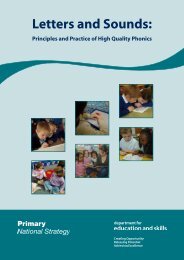What is the research evidence on writing? - Department for Education
What is the research evidence on writing? - Department for Education
What is the research evidence on writing? - Department for Education
Create successful ePaper yourself
Turn your PDF publications into a flip-book with our unique Google optimized e-Paper software.
level 2C and 6 per cent achieving a level 1 in <strong>writing</strong>. Overall, 44 per cent of pupils<br />
achieving level 2B in reading are achieving a lower level in <strong>writing</strong>.<br />
Table 6<br />
100%<br />
90%<br />
80%<br />
70%<br />
60%<br />
50%<br />
40%<br />
30%<br />
20%<br />
10%<br />
0%<br />
KS1 Reading Level by KS1 Writing Level<br />
A D IN W 1 2C 2B 2A 3 4<br />
KS1 Reading<br />
KS1 Writing Level A<br />
KS1 Writing Level D<br />
KS1 Writing Level IN<br />
KS1 Writing Level W<br />
KS1 Writing Level 1<br />
KS1 Writing Level 2C<br />
KS1 Writing Level 2B<br />
KS1 Writing Level 2A<br />
KS1 Writing Level 3<br />
KS1 Writing Level 4<br />
The same pattern occurs with pupils achieving level 2A and 3 in reading. More than<br />
half of <str<strong>on</strong>g>the</str<strong>on</strong>g>se pupils (who are per<strong>for</strong>ming above <str<strong>on</strong>g>the</str<strong>on</strong>g> expected level in reading) are<br />
achieving a lower level in <strong>writing</strong>. Girls are more likely to per<strong>for</strong>m better than boys,<br />
with over half of girls achieving level 3 or above in both reading and <strong>writing</strong><br />
compared to <strong>on</strong>ly 38 per cent of boys. FSM and SEN pupils are less likely to per<strong>for</strong>m<br />
as well in <strong>writing</strong> as <str<strong>on</strong>g>the</str<strong>on</strong>g>y do in reading compared to pupils not eligible <strong>for</strong> FSM and<br />
without SEN respectively.<br />
Children whose first language was ‘o<str<strong>on</strong>g>the</str<strong>on</strong>g>r than Engl<str<strong>on</strong>g>is</str<strong>on</strong>g>h’ are slightly more likely to<br />
per<strong>for</strong>m as well in <strong>writing</strong> as <str<strong>on</strong>g>the</str<strong>on</strong>g>y do in reading compared to children whose first<br />
language was Engl<str<strong>on</strong>g>is</str<strong>on</strong>g>h. The per<strong>for</strong>mance of most ethnic groups <str<strong>on</strong>g>is</str<strong>on</strong>g> similar <strong>for</strong> reading<br />
and <strong>writing</strong> outcomes.<br />
Key Stage 2<br />
In 2012, 81 per cent of pupils achieved <str<strong>on</strong>g>the</str<strong>on</strong>g> expected level (level 4 or above) based <strong>on</strong><br />
<strong>writing</strong> teacher assessment, compared to 75 per cent of pupils achieving <str<strong>on</strong>g>the</str<strong>on</strong>g><br />
expected level in 2011, based <strong>on</strong> nati<strong>on</strong>al tests. Eighty seven per cent of pupils<br />
achieved <str<strong>on</strong>g>the</str<strong>on</strong>g> expected level in reading and 84 per cent in ma<str<strong>on</strong>g>the</str<strong>on</strong>g>matics. Some<br />
difference between test and teacher assessment results can be expected as <str<strong>on</strong>g>the</str<strong>on</strong>g><br />
outcomes are measured in different ways. Reading and <strong>writing</strong> teacher assessments<br />
are not available prior to 2012, but a compar<str<strong>on</strong>g>is</str<strong>on</strong>g><strong>on</strong> of Engl<str<strong>on</strong>g>is</str<strong>on</strong>g>h test and Engl<str<strong>on</strong>g>is</str<strong>on</strong>g>h teacher<br />
assessment outcomes since 2007 suggests that <str<strong>on</strong>g>the</str<strong>on</strong>g>y differed by no more than 2<br />
percentage points in any year (DfE, 2012b).<br />
Looking at <str<strong>on</strong>g>the</str<strong>on</strong>g> <strong>writing</strong> results in more detail, <str<strong>on</strong>g>the</str<strong>on</strong>g> gender gap still pers<str<strong>on</strong>g>is</str<strong>on</strong>g>ts, with 76 per<br />
cent of boys achieving <str<strong>on</strong>g>the</str<strong>on</strong>g> expected level compared to 87 per cent of girls. The<br />
gender gap <str<strong>on</strong>g>is</str<strong>on</strong>g> less pr<strong>on</strong>ounced in reading, ma<str<strong>on</strong>g>the</str<strong>on</strong>g>matics and science.<br />
36
















